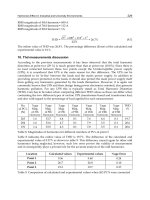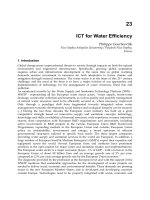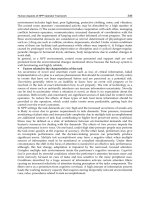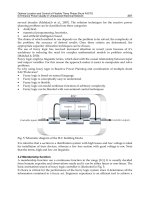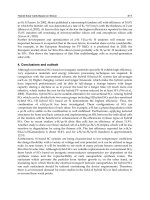Protein Purification Part 13 potx
Bạn đang xem bản rút gọn của tài liệu. Xem và tải ngay bản đầy đủ của tài liệu tại đây (295.39 KB, 15 trang )
Lectins: To Combat Infections
173
components of the cell wall of oral pathogen, Streptococcus mutans. Lectins from Canavalia
ensiformis (ConA), Trigonella foenumgraecum (TFA), Triticum aestivum (WGA), Arachis
hypogaea (PNA), Cajanus cajan (CCL), Phaseolus vulgaris (PHA) and Pisum sativum (PSA) were
tested against the growth and biofilm formation of S. mutans on saliva coated surface. None
of these lectins inhibit the bacterial growth even up to a concentration of 1000mg/ml.
However, all the lectins inhibited the biofilm formation by S.mutans in-vitro. Amongst these,
lectins with Mannose/Glucose (ConA, TFA, CCL and PSA) specificity showed the highest
inhibitory effect on the biofilm formation while lectins with N-acetylglucosamine specificity
(WGA and PHA) and N-acetylgalactosamine specificity (PNA) also showed inhibition,
albeit to a lesser degree (Islam et al., 2009).
Organism Target tissue Carbohydrate For
m
b
C. jejuni
c
Intestinal Fucα2GalβGlcNAc GP
E. coli Type 1 Urinary Manα3Manα6Man GP
P Urinary Galα4Gal GSL
S Neural NeuAc (α2–3)Galβ3GalNAc GSL
CFA/1 Intestinal NeuAc (α2–8)– GP
F1C
d
Urinary GalNAcβ4Galβ GSL
F17
e
Urinary GlcNAc GP
K1 Endothelial GlcNAcβ4GlcNAc GP
K99 Intestinal NeuAc(α2–3)Galβ4Glc GSL
H. influenzae
Respiratory [NeuAc(α2–3)]
0,1
Galβ4GlcNAcβ3Galβ4GlcNAc GSL
H. pylori
Stomach NeuAc(α2–3)Galβ4GlcNAc GP
Fucα2Galβ3(Fucα4)Gal GP
K. pneumoniae
Respiratory Man GP
N. gonorrhoea
Genital Galβ4Glc(NAc) GSL
N. meningitidis
Respiratory [NeuAc(α2–3)]
0,1
Galβ4GlcNAcβ3Galβ4GlcNAc GSL
P. aeruginosa
f
Respiratory L-Fuc GP
Respiratory Galβ3Glc(NAc)β3Galβ4Glc GSL
S. typhimurium
Intestinal Man GP
S. pneumoniae
Respiratory [NeuAc(α2–3)]
0,1
Galβ4GlcNAcβ3Galβ4GlcNAc GSL
S. suis
Respiratory Galα4Galβ4Glc GSL
Source: Gupta et al., 2009.
Table 5. Carbohydrates as attachment sites for bacterial pathogens on animal tissues
a
A surface glycoprotein of S.mutans of 60 kDa (with mannose and N-acetylgalactosamine)
has been known to involve in saliva and bacterial interaction. The lesser adherence in the
presence of glucose/mannose and galactosamine specific lectins could be because of the
interaction with this protein. The PHA and WGA lectin binds to a constituent of the
peptidoglycan of the cell wall (Sharon and Lis 2003). The attachment of bacteria is mediated
by glucan binding lectin (GBL) and the presence of lectin in the growth media perhaps leads
to competition between GBL of bacteria and plant lectins for the attachment sites on salive-
coated plates resulting in less binding of the cells. With regard to bacterial surface lectins
Protein Purification
174
that often play a role in the initial step of adherence, plant lectins by interfering in this
process show a promising future as anti-adherence agents (Islam et al., 2009). A schematic
description of how lectins might inhibit attachment of bacteria to the host tissue is shown in
Figure 1 (Ghazarian et al., 2011).
Use of bacterial lectin inhibitors such as mannose to prevent the adhesion of Eschericia coli to
bladder epithelial cells has been employed in clinical practice for some time. Other
bioglycans, such as that from Crenomytalus grayanus (mussels), has been found to
considerably decrease the adhesion of the bacteria Eschericia coli, Staphylococcus aureus and
Pseudomonas aeruginosa (Zaporozhets et al., 1994). Plant lectins such as those from Datura
stramonium, Robinia pseudoacacia and Dolichos biflorus agglutinated Streptococcal Group C
bacterial cells (Kellens et al., 1994) which prevents them from adhering to human cell
surfaces.
4. Antiviral effect of lectin
The surfaces of retroviruses such as human immunodeficiency virus (HIV) and many other
enveloped viruses are covered by virally-encoded glycoproteins. Glycoproteins gp120 and
gp41 present on the HIV envelope are heavily glycosylated, with glycans estimated to
contribute almost 50% of the molecular weight of gp120 (Mizuochi et al., 1988; Ji et al., 2006).
The antiviral activity of lectins appears to depend on their ability to bind mannose-
containing oligosaccharides present on the surface of viral envelope glycoproteins. Agents
that specifically and strongly interact with the glycans may disturb interactions between the
proteins of the viral envelope and the cells of the host (Botos & Wlodawer, 2005; Balzarini,
2006). Sugar-binding proteins can crosslink glycans on the viral surface (Sacchettini et al.,
2001; Shenoy et al., 2002) and prevent further interactions with the co-receptors. Unlike the
majority of current antiviral therapeutics that act through inhibition of the viral life cycle,
lectins can prevent penetration of the host cells by the viruses. Antiviral lectins are best
suited to topical applications and can exhibit lower toxicity than many currently used
antiviral therapeutics. Additionally, these proteins are often resistant to high temperatures
and low pH, as well as being odorless, which are favorable properties for potential
microbicide drugs. Antiviral activity of a number of lectins that bind high-mannose
carbohydrates has been described in the past. Examples of such lectins include jacalin
(O’Keefe et al., 1997), concanavalin A (Hansen et al., 1989), Urtica diocia agglutinin
(Balzarini et al., 1992), Myrianthus holstii lectin (Charan et al., 2000), and Narcissus
pseudonarcissus lectin (Balzarini et al., 1991). However, lectins derived from marine
organisms, a rich source of natural antiviral products (Tziveleka et al., 2003), such as CV-N
(Boyd et al., 1997), SVN (Bokesch et al., 2003), MVL (Bewley et al., 2004) and GRFT (Mori et
al., 2005), exhibit the highest activity among the lectins that have been investigated so far
(Ziółkowska NE and Wlodawer A 2006). Some lectins found in algae, such as cyanovirin-N
(CV-N) (Boyd et al., 1997; Esser et al., 1999; Barrientos et al., 2003; O’Keefe et al., 2003;
Helleet al., 2006); scytovirin (SVN) (Bokesch et al., 2003), Microcystis viridis lectin (MVL)
(Bewley et al., 2004), and griffithsin (GRFT) (Mori et al., 2005; Ziółkowska et al., 2006) exhibit
significant activity against human immunodeficiency virus (HIV) and other enveloped
viruses, which makes them particularly promising targets for the development as novel
antiviral drugs (De Clercq, 2005; Reeves & Piefer, 2005)
Lectins: To Combat Infections
175
Fig. 1. Representation of bacterial lectins binding to the host cell (left) and specific lectins,
used as drug interfering with this bacteria-host interaction (right)
Keyaerts et al., (2007) described the antiviral activity of plant lectins with specificity for
different glycan structures against the severe acute respiratory syndrome coronavirus
(SARS-CoV) and the feline infectious peritonitis virus (FIPV) in vitro. The SARS-CoV
emerged in 2002 as an important cause of severe lower respiratory tract infection in humans,
and FIPV infection causes a chronic and often fatal peritonitis in cats. A unique collection of
33 plant lectins with different specificities were evaluated. The plant lectins possessed
marked antiviral properties against both coronaviruses with EC50 values in the lower
microgram/ml range (middle nanomolar range), being non-toxic (CC50) at 50–100 μg/ml.
The strongest anti-coronavirus activity was found predominantly among the mannose-
binding lectins. In addition, a number of galactose-, N-acetylgalactosamine-, glucose-, and
N-acetylglucosamine-specific plant agglutinines exhibited anti-coronaviral activity. A
significant correlation (with an r-value of 0.70) between the EC50 values of the 10 mannose-
specific plant lectins effective against the two coronaviruses was found. In contrast, little
correlation was seen between the activities of other types of lectins. Two targets of possible
antiviral intervention were identified in the replication cycle of SARS-CoV. The first target is
located early in the replication cycle, most probably viral attachment, and the second target
is located at the end of the infectious virus cycle (Keyaerts et al., 2007).
Protein Purification
176
The carbohydrate binding profile of the red algal lectin KAA-2 from Kappaphycus alvarezii
was studied by Sato et al (2011). They tested the anti-influenza virus activity of KAA-2
against various strains including the recent pandemic H1N1-2009 influenza virus. KAA-2
inhibited infection of various influenza strains with EC50s of low nanomolar levels.
Immunofluorescence microscopy using an anti-influenza antibody demonstrated that the
antiviral activity of KAA-2 was exerted by interference with virus entry into host cells. This
mechanism was further confirmed by evidence of direct binding of KAA-2 to a viral
envelope protein, hemagglutinin (HA), using an ELISA assay. These results indicate that
this lectin could be a useful antiviral agent (Sato Y et al., 2011).
5. Antifungal effects of lectins
Despite the large numbers of lectins and hemagglutinins that have been purified, only a few
of them manifested antifungal activity (Table 5). The expression of Gastrodia elata lectins in
the vascular cells of roots and stems was strongly induced by the fungus Trichoderma viride,
indicating that lectin is an important defense protein in plants (Sá et al., 2009). Following
insertion of the precursor gene of stinging nettle isolectin I into tobacco, the germination of
spores of Botrytis cinerea, Colletotrichum lindemuthianum, and T. viride was significantly
reduced (Does et al., 1999). Thus, lectins may be introduced into plants to protect them from
fungal attack.
Plant lectins can neither bind to glycoconjugates on the fungal membranes nor penetrate the
cytoplasm owing to the cell wall barrier. It is not likely that lectins directly inhibit fungal
growth by modifying fungal membrane structure and/or permeability. However, there may
be indirect effects produced by the binding of lectins to carbohydrates on the fungal cell
wall surface. Chitinase-free chitin-binding stinging nettle (Urtica dioica lectin) impeded
fungal growth. Cell wall synthesis was interrupted because of attenuated chitin synthesis
and/or deposition (Van Parijs et al., 1991). The effects of nettle lectin on fungal cell wall and
hyphal morphology suggest that the nettle lectin regulates endomycorrhizal colonization of
the rhizomes. Severa1 other plant lectins inhibit fungal growth. The first group includes
small chitin-binding merolectins with one chitin-binding domain, e.g., hevein from rubber
tree latex (Van Parijs et al., 1991) and chitin-binding polypeptide from Amaranthus caudatus
seeds (Broekaert et al., 1992). The only plant lectins that can be considered as fungicidal
proteins are the chimerolectins belonging to the class I chitinases. However, the antifungal
activity of these proteins is ascribed to their catalytic domain.
6. Lectins and the immune system
To initiate immune responses against infection, the surface receptors on antigen
presenting cells must recognise the corresponding molecules on infectious agents.
Pattern recognition receptors (PRR) which include C-type lectin like receptor (CLR)
recognise and interact with carbohydrate moieties of many pathogens. Despite the
presence of a highly conserved domain, C-type lectins are functionally diverse and have
been implicated in various processes including cell adhesion, tissue integration and
remodelling, platelet activation, complement activation, pathogen recognition,
endocytosis, and phagocytosis.
Lectins: To Combat Infections
177
Natural source of lectin Fungal species inhibited Sugar specificity Reference
Amaranthus viridis
(Green Amaranth) seeds
Botrytis cinerea,
Fusarium oxysporum
Asialofetuin,
fetuin,
T-antigen, N-
acetyl-d-
lactosamine,
N-acetyl-d-
galactosamine
Kaur et
al.2006
Astragalus mongholicus
(huangqi) roots
Borrytis cinerea,
Colletrichum sp.,
Droschslara turia,
Fusarium oxysporum
d-galactose,
lactose
Yan et
al.2005
Capparis spinosa (caper) seeds
Valsa mali
D(+)galactose,
α-lactose,
raffinose,
rhamnose,
L(+)-arabinose,
D(+)glucosamine
Lam et
al.2009
Capsicum frutescens
(red cluster pepper) seeds
Aspergillus flavus,
Fusarium moniliforme
d-mannose,
glucose
Ngai and
Ng 2007
Curcuma amarissima Roscoe
(wei ji ku jiang-huang)
Rhizomes
Colectrotrichum cassiicola,
Exserohilum turicicum,
Fusarium oxysporum
Not found Kheeree et
al. 2010
Dendrobium findlayanum
(orchid) pseudobulbs
Alternaria alternata,
Colletrichum sp.
Not found Sattayasai
et al. 2009
Phaselous vulgaris cv “
flageolet bean” seeds
Mycosphaerella arachidicola
Not found Xia and Ng
2005
Phaselous vulgaris cv
“French bean 35” seeds
Valsa mali
Not found Lam and
Ng 2010
Phaseolus coccineus seeds
Gibberalla sanbinetti,
Helminthosporium maydis,
Rhizoctonia solani,
Sclerotinia sclerotiorum
Sialic acid Chen et
al.2009
Phaseolus vulgaris cv
“red kidney bean” seeds
Coprinus comatus,
Fusarium oxysporum,
Rhizoctonia solani
Lactoferrin,
ovalbumin,
thyroglobulin
Ye et al.
2001
Pouteria torta
(pouteria trees/eggfruits)
seeds
Saccharomyces carevisiae, C.
musae, Fusarium
oxysporum
Fetuin,
asialofetuin,
heparin,
orosomucoid,
ovoalbumin
Boleti et
al.2007
Talisia esculenta (pitomba)
seeds
Microsporum canis
d-mannose Pinheiro et
al. 2009
Protein Purification
178
Natural source of lectin Fungal species inhibited Sugar specificity Reference
Withania somnifera
(Ashwagandha/Indian
ginseng/Winter
cherry/Ajagandha/Kanaje
Hindi/Amukkuram) leaves
Fusarium moniliforme,
Macrophomina phaseolina
Not found Ghosh
2009
Zea mays (maize) endosperm
Aspergillus flavus
D(+)galactose Baker et
al.,2009
Table 6. Examples of lectins with antifungal activity, Source: Lam and Ng, 2011
6.1 Mannose Receptor
The MR binds a broad array of microorganisms, including Candida albicans, Pneumocystis
carinii, Leishmania donovani, Mycobacterium tuberculosis, and capsular polysaccharides of
Klebisella pneumoniae and Streptococcus pneumonia (Chakraborty et al., 2001; Ezekowitz et al.,
1991; Marodi et al., 1991; O’Riordan et al., 1995; Schlesinger, 1993; Zamze et al., 2002). The
receptor recognises mannose, fucose or N-acetylglucosamine sugar residues on the surfaces
of these microorganisms (Largent et al., 1984) and carbohydrate recognition is mediated by
CTLDs 4–8 (Taylor et al., 1992). The MR has been implicated in the phagocytic uptake of
pathogens, but there are limited examples actually demonstrating MR-dependent
phagocytosis.
6.2 Dectin-1
Dectin-1 is a type II transmembrane protein that is classified as a Group V non-classical C-
type lectin and lacks the conserved residues involved in the ligation of calcium that are
usually required to co-ordinate carbohydrate binding. Dectin-1 was initially identified as a
dendritic cell specific receptor that modulates T cell function through recognition of an
unidentified ligand (Ariizumi et al., 2000; Grunebach et al., 2002). It was subsequently
reidentified as a receptor for β-glucans, which are carbohydrate polymers found primarily
in the cell walls of fungi, but also in plants and some bacteria (Brown and Gordon, 2001,
2003). Dectin-1 can recognise a number of fungal species, including C. albicans, P. carinii,
Saccharomyces cerevisiae, Coccidioides posadasii and Aspergillus fumigatus (Brown et al., 2003;
Gersuk et al., 2006; Saijo et al., 2007; Steele et al., 2003, 2005; Taylor et al., 2007; Viriyakosol et
al., 2005).The ligation of Dectin-1 also triggers intracellular signalling resulting in a variety
of cellular responses, including phagocytosis.
6.3 DC-SIGN (CD209)
DC-SIGN is a type II transmembrane protein that is classified as a Group II C-type lectin.
DC-SIGN was originally identified as a receptor for intercellular adhesion molecule-3
(ICAM-3) that facilitates DC-mediated T-cell proliferation and binds HIV-1 (Geijtenbeek et
al., 2000a, b). It has since been reported that the receptor interacts with a range of pathogens,
including M. tuberculosis, C. albicans, Helicobacter pylori, Schistosoma mansoni and A. fumigatus
(Appelmelk et al., 2003; Cambi et al., 2008; Geijtenbeek et al., 2000b, 2003; Serrano-Gomez et
al., 2004; Tailleux et al., 2003; van Die et al., 2003). There have been no reports of a
Lectins: To Combat Infections
179
mechanism for DC-SIGN mediated phagocytosis. However, activation of DC-SIGN triggers
Rho-GTPase (Hodges et al., 2007) making it conceivable that Rho could be involved in
phagocytosis mediated by this receptor.
6.4 Mannose-binding lectin (MBL)
Mannose-binding lectin (MBL) is a Group III C-type lectin belonging to the collectins
(Holmskov et al., 2003), which are a group of soluble oligomeric proteins containing
collagenous regions and CTLDs. MBL is secreted into the blood stream as a large multimeric
complex and is primarily produced by the liver, although other sites of production, such as
the intestine, have been proposed (Uemura et al., 2002). It recognises carbohydrates such as
mannose, glucose, l-fucose, N-acetyl-mannosamine (ManNAc), and N-acetyl-glucosamine
(GlcNAc). Oligomerisation of MBL enables high avidity binding to repetitive carbohydrate
ligands, such as those present on a variety of microbial surfaces, including E. coli, Klebisella
aerogenes, Neisseria meningitides, Staphylococcus aureus, S. pneumoniae, A. fumigatus and C.
albicans (Davies et al., 2000; Neth et al., 2000; Schelenz et al., 1995; Tabona et al., 1995; van
Emmerik et al., 1994).MBL has also been proposed to function directly as an opsonin by
binding to carbohydrates on pathogens and then interacting with MBL receptors on
phagocytic cells, promoting microbial uptake and stimulating immune responses (Kuhlman
et al., 1989). It was shown in a recent study that MBL modifies cytokine responses through a
novel cooperation with TLR2/6 in the phagosome (Ip et al., 2008).
7. Lectins and drug delivery
The concept of lectin-mediated specific drug delivery was proposed by Woodley and
Naisbett in 1988 (Bies et al., 2004). Delivery of targeted therapeutics via direct and reverse
drug delivery systems (DDS) to specific sites provides numerous advantages over
traditional non-targeted therapeutics (Rek et al., 2009). Targeted drug delivery increases the
efficacy of treatment by enhancing drug exposure to targeted sites while limiting side effects
of drugs on normal and healthy tissues (Rek et al., 2009). Furthermore, specific drug
delivery increases the uptake and internalization of therapeutics that have reduced cellular
permeability (Rek et al., 2009). Lectin based drug-targeting can be done in two ways. In the
first approach, carbohydrate moieties form a part of DDS. The carbohydrate tag drives the
drug to the endogenous lectins present on the cell surface. In the second approach, lectins
are present on the drug surface and it interacts with the glycosylated surfaces of the cells
(Gabor et al., 2004). Considering the fact that epithelial cells contain a thin layer of mucus
which has mucins that are highly glycosylated proteins, the lectin-encapsulated drug
strategy offers great potential. As non-specific interactions are susceptible to changes in pH
and to interactions with food digesta, which probably reduce the mucoadhesive effect,
specific mucoadhesiva of the second generation seem to be preferable. The second target is
the glycocalyx of the absorptive epithelium. In case of identical oligosaccharide structures of
the mucin and the glycocalyx, partitioning of the formulation to the cell surface is facilitated
due to full reversibility of the mucin–lectin interaction. In case of lectin-matching
carbohydrates only at the glycocalyx, the formulation has to penetrate the mucuos layer.
Both pathways result in fixation of the drug delivery system closer to the site of absorption.
That way cytoadhesion will increase the concentration gradient between the extracellular
and intracellular compartment, which facilitates at least passive diffusion of the drug into
Protein Purification
180
the cell. The third target is represented by glycosylated receptors at the cell membrane. The
binding of some lectins, such as WGA to the EGF-receptor, induces active receptor mediated
endocytosis, which can improve cytoinvasion of prodrugs as well as nanoscaled carrier
systems (Gabor, 2004).
In an approach towards pulmonary delivery, lectinised liposomes (130–170 nm in diameter)
were screened for binding to alveolar type II epithelial cells (Bruck et al., 2001). As
compared to plain liposomes, the binding to A549 cells increased 6–11-fold upon surface
modification with wheat germ agglutinin (WGA), Concanavalin A (ConA) or soybean
agglutinin. The binding was not affected by a synthetic lung surfactant and no cytotoxic
effect of the free lectins or the lectinised liposomes was observed. Upon incubation with
primary cultured human alveolar epithelial cells, which exhibit barrier functions, the WGA-
liposomes were not only bound but also taken up into the cells. In search for non-viral
vectors for gene therapy of cystic fibrosis and as a basis for lectin-mediated gene transfer, 32
lectins were screened for binding and uptake into living human airway epithelium (Yi et al.,
2001). Whereas ConA was internalised within 1 h, the lectins from Erythrina cristagalli and
Glycine max, peanut lectin, and Jacalin were taken up into the epithelium within 4 h. The
endocytosis of WGA was minimal even after 4 h. Irrespective of the specificity of the lectin–
carbohydrate interaction; the internalised lectins exhibited a non-selective binding pattern on
the epithelium. Only peanut lectin bound to subpopulations of ciliated and non-ciliated cells.
Owing to their remarkable specificities, plant lectins with affinities for the carbohydrates on
microbial cell surface are already well characterised. Given the potential of porphyrins to act
as antimicrobials it is pertinent to ask whether lectins could be used in vivo to specifically
deliver porphyrins into pathogenic microbial cells, thereby improving the efficacy of the
treatment, reducing the concentration of the drug required to be introduced into the system
and thereby reducing the possible side-effects. In particular, lectins could be successful oral
and mucosal drug delivery agents. Not only are a large number of lectins part of our
everyday diet, but also several of them are known to survive the harsh conditions of human
gastro-intestinal tract. Similarly, attempts have been made to use lectins in ocular drug
delivery. Specific hydrophobic binding sites on lectins provide the ideal opportunity to
expand the use of these molecules in targeted therapy (Komath et al., 2006).
8. Conclusions
Lectins are ubiquitous in nature and have garnered much attention due to specificity of its
interaction with the carbohydrates. Glycosylation is a key step in many cellular processes
and with more reports about the change in cell-surface carbohydrates in different
pathological conditions, research about exploiting lectins as a therapeutic tool is now at the
forefront. Lectins are now routinely used in the identification and purification of
glycoproteins. Their use in blood typing as well as in clinical diagnostics is well established.
Many lectins show antibacterial, antiviral or antifungal activities in-vitro. However, clinical
trials need to be done for establishing their therapeutic effect and optimising their dosage
delivery. As microbes use their surface lectins for attachment to the host tissue,
dietary/therapeutic lectins may interfere in this interaction. Thus lectins can be used anti-
adhesion agents and prevent the colonization of the microbe and hence the establishment of
the infection. In the immune system, endogenous lectins play a role in ligand recognition
and hence are an important component of the host’s defense against microbes. Given their
Lectins: To Combat Infections
181
ability to specifically target different cell types, they have always been looked upon as
useful candidates for targeted drug delivery. Research utilizing lectins as carriers of
monoclonal antibodies or specific chemotherapeutic agents has been conducted. Alongwith
the beneficial effect, lectins have been reported to have caused severe allergic reactions.
Most of the information on the acute toxicity of lectins in humans has been derived from
observations of incidences of accidental poisoning. Since no experimental data is available to
show the possible adverse effects of lectins on humans but can be inferred from experiments
with laboratory animals. Although results obtained with mice, rats or pigs cannot simply be
extrapolated to humans, the observed effects on the gut and other organs of these animals
demonstrate the possible toxicity of the lectins. Thus lectin-based therapeutics for combating
infections is very promising owing to its highly selective nature, provided the dosage is well
below the toxic limits.
9. References
[1] Ambrosi M, Cameron NR & Davis BG (2005). Lectins : tools for molecular understanding
of the glycocode. Org Biol Chem. (3), 1593-1608.
[2] Appelmelk BJ, van Die I, van Vliet SJ, Vandenbroucke-Grauls CM, Geijtenbeek TB & van
Kooyk Y (2003). Carbohydrate profiling identifies new pathogens that interact with
dendritic cell-specific ICAM-3 grabbing nonintegrin on dendritic cells. J Immunol.
170, 1635–1639.
[3] Ariizumi K, Shen GL, Shikano S, Xu S, Ritter R, Kumamoto T, Edelbaum D, Morita A,
Bergstresser PR & Takashima A (2000). Identification of a novel, dendritic cell-
associated molecule, dectin-1, by subtractive cDNA cloning. J. Biol. Chem. 275,
20157–20167.
[4] Baker RL, Brown RL, Chen ZY, Cleveland TE, Fakhoury AM (2009). A maize lectin-like
protein with antifungal activity against Aspergillus flavus. J Food Prot. 72, 120–127.
[5] Balls AK, Halle WS and Harris TH (1942). A crystalline protein obtained from a
lipoprotein of wheat flour. Cereal Chem.19, 279-288.
[6] Balzarini J (2006).Large-molecular-weight carbohydrate-binding agents as HIV entry
inhibitors targeting glycoprotein gp120. Curr Opin HIV AIDS, 1(5), 355-360.
[7] Balzarini J, Neyts J, Schols D, Hosoya M, Van Damme E, Peumans W & De Clercq E
(1992). The mannose-specific plant lectins from cymbidium hybrid and epipactis
helleborine and the (N-acetylglucosamine)n-specific plant lectin from Urtica dioica
are potent and selective inhibitors of human immunodeficiency virus and
cytomegalovirus replication in vitro. Antiviral Res. 18, 191–207.
[8] Balzarini J, Schols D, Neyts J, Van Damme E, Peumans W& De Clercq E (1991). Alpha-
(1-3)- and alpha-(1-6)-d-mannose-specific plant lectins are markedly inhibitory to
human immunodeficiency virus and cytomegalovirus infections in vitro.
Antimicrob. Agents Chemother. 35, 410–416.
[9] Bergsten G, Wullt B, Svanborg C (2005). Escherichia coli, fimbriae, bacterial persistence
and host response induction in the human urinary tract. Int J Med Microbiol.,
295(6-7), 487-502.
[10] Bernhard W, Gbarah A and Sharon N (1992). Lectinophagocytosis of type 1fimbriated
(mannose-specific) Escherichia coli in the mouse peritoneum. J. Leukocyte Biol. 52,
343–348., Cai M, Ray S, Ghirlando R, Yamaguchi M & Muramoto K (2004).New
carbohydrate specificity and HIV-1 fusion blocking activity of the cyanobacterial
Protein Purification
182
protein MVL: NMR, ITC and sedimentation equilibrium studies. J Mol Biol. 339(4),
901-914.
[11] Bokesch HR, O'Keefe BR, McKee TC, Pannell LK, Patterson GM, Gardella RS, Sowder
RC 2nd, Turpin J, Watson K, Buckheit RW Jr & Boyd MR (2003). A potent novel
anti-HIV protein from the cultured cyanobacterium Scytonema varium.
Biochemistry. 42(9), 2578-2584.
[12] Boleti AP, Freire MG, Coelho MB, Silva W, Baldasso PA, Gomes VM, Marangoni S,
Novello JC & Macedo ML (2007). Insecticidal and antifungal activity of a protein from
Pouteria torta seeds with lectin-like properties. J Agric Food Chem. 55, 2653–2658.
[13] Boyd MR, Gustafson KR, McMahon JB, Shoemaker RH, O'Keefe BR, Mori T,
Gulakowski RJ, Wu L, Rivera MI, Laurencot CM, Currens MJ, Cardellina JH 2nd,
Buckheit RW Jr, Nara PL, Pannell LK, Sowder RC 2nd & Henderson LE (1997).
Discovery of cyanovirin-N, a novel human immunodeficiency virus-inactivating
protein that binds viral surface envelope glycoprotein gp120: potential applications
to microbicide development.Antimicrob Agents Chemother. 41(7),1521-1530.
[14] Broekaert WF, Mariën W, Terras FR, De Bolle MF, Proost P, Van Damme J, Dillen L,
Claeys M, Rees SB, Vanderleyden J, et al (1992). Antimicrobial peptides from
Amaranthus caudatus seeds with sequence homology to the cysteine/glycine-rich
domain of chitin-binding proteins. Biochemistry 31(17), 4308-4314.
[15] Brooks SA, Hall DM & Buley I (2001). GalNAc glycoprotein expression by breast cell
lines, primary breast cancer and normal breast epithelial membrane. Br J Cancer
85(7), 1014-1022.
[16] Brown GD & Gordon S (2001). Immune recognition. A new receptor for beta-glucans.
Nature 413, 36–37.
[17] Brown GD & Gordon S (2003). Fungal beta-glucans and mammalian immunity.
Immunity 19, 311–315.
[18] Brown GD, Herre J, Williams DL, Willment JA, Marshall AS & Gordon S (2003). Dectin-
1 mediates the biological effects of beta-glucans. J. Exp. Med. 197, 1119–1124.
[19] Bruck A, Abu-Dahab R, Borchard G, Schafer UF & Lehr CM (2001). Lectin-
functionalized liposomes for pulmonary drug delivery: interaction with human
alveolar epithelial cells, J. Drug Targeting 9 (2001) 241– 251.
[20] Cambi A, Netea MG, Mora-Montes HM, Gow NA, Hato SV, Lowman DW, Kullberg BJ,
Torensma R, Williams DL & Figdor CG (2008). Dendritic cell interaction with
Candida albicans critically depends on N-linked mannan. J. Biol. Chem. 283, 20590–
20599.
[21] Chakraborty P, Ghosh D & Basu MK (2001).Modulation of macrophage mannose
receptor affects the uptake of virulent and avirulent Leishmania donovani
promastigotes. J Parasitol 87(5), 1023-1027.
[22] Charan RD, Munro MH, O'Keefe BR, Sowder RCII, McKee TC, Currens MJ, Pannell LK,
Boyd MR (2000). Isolation and characterization of Myrianthus holstii lectin, a
potent HIV-1 inhibitory protein from the plant Myrianthus holstii(1). J Nat Prod.,
63(8),1170-1174.
[23] Charungchitrak S, Petsom A, Sangvanich P & Karnchanatat A (2011). Antifungal and
antibacterial activities of lectin from the seeds of Archidendron jiringa Nielsen.
Food Chemistry 126, 1025–1032.
Lectins: To Combat Infections
183
[24] Chen J, Liu B, Ji N, Zhou J, Bian HJ, Li CY, Chen F& Bao JK (2009). A novel sialic acid-
specific lectin from Phaseolus coccineus seeds with potent antineoplastic and
antifungal activities. Phytomedicine 16, 352–360.
[25] Davies J, Neth O, Alton E, Klein N & Turner M (2000). Differential binding of mannose-
binding lectin to respiratory pathogens in cystic fibrosis. Lancet. 355, 1885–1886.
[26] De Bolle MF, Osborn RW, Goderis IJ, Noe L, Acland D, Hart CA, Torrekens S, van
Leuven F, Broekart NF(1996). Antimicrobial properties from Mirablis jalapa and
Amaranthus caudalus: Expression, processing, localization and biological activity in
transgenic tobacco. Plant Mol. Biol. 31, 993-1008.
[27] Does MP, Houterman PM, Dekker HL & Cornelissen BJ (1999) Processing, targeting,
and antifungal activity of stinging nettle agglutinin in transgenic tobacco. Plant
Physiol 120, 421–432.
[28] Dong CH, Yang ST, Yang ZA, Zhang L & Gui JF (2004). A C-type lectin associated and
translocated with cortical granules during oocyte maturation and egg fertilization
in fish. Dev. Biol. 265, 341–354.
[29] Duguid, JP and Old DC (1980) in Bacterial Adherence, Beachey EH, ed, pp 185-217,
Chapman and Hall, London.
[30] Dutta S, Sinha B, Bhattacharya B, Chatterjee B, Mazumder S (2005). Characterization of
a galactose binding serum lectin from the Indian catfish, Clarias batrachus: Possible
involvement of fish lectins in differential recognition of pathogens. Comparative
Biochemistry and Physiology Part C 141, 76 – 84.
[31] Etzler, ME (1986). Distribution and function of plant lectins. In The Lectins. Properties,
Function, and Applications in Biology and Medicine, Liener IE, Sharon N, Goldstein IJ,
eds; pp. 371-435, Academic Press: Orlando, FL, USA.
[32] Ezekowitz RA, Williams DJ, Koziel H, Armstrong MY, Warner A, Richards FF, Rose RM
(1991). Uptake of Pneumocystis carinii mediated by the macrophage mannose
receptor. Nature 351(6322), 155-158.
[33] Gabius HJ, Walzel H, Joshi SS, Kruip J, Kojima S, Gerke V, Kratzin H & Gabius S (1992).
The immunomodulatory beta-galactoside-specific lectin from mistletoe: partial
sequence analysis, cell and tissue binding, and impact on intracellular biosignalling
of monocytic leukemia cells. Anticancer Res. 12(3), 669-75.
[34] Gabius S, Joshi S, Kayser K & Gabius H (1992). The galactoside-specific lectin from
mistletoe as biological response modifier. Int J Oncol. 1(6), 705-708.
[35] Gaynor CD, McCormack FX, Voelker DR, McGowan SE & Schlesinger LS. Pulmonary
surfactant protein A mediates enhanced phagocytosis of Mycobacterium
tuberculosis by a direct interaction with human macrophages.J Immunol. 155(11),
5343-5351.
[36] Geijtenbeek TB, Torensma R, van Vliet SJ, van Duijnhoven GC, Adema GJ, van Kooyk Y
& Figdor CG (2000). Identification of DC-SIGN, a novel dendritic cell-specific
ICAM-3 receptor that supports primary immune responses. Cell. 100, 575–585.
[37] Geijtenbeek TB, Van Vliet SJ, Koppel EA, Sanchez-Hernandez M, Van denbroucke-
Grauls CM, Appelmelk B & Van Kooyk Y (2003). Mycoba
cteria target DC-SIGN to
suppress dendritic cell function. J. Exp. Med. 197, 7–17.
[38] Gersuk GM, Underhill DM, Zhu L & Marr KA (2006). Dectin-1 and TLRs permit
macrophages to distinguish between different Aspergillus fumigatus cellular states.
J. Immunol. 176, 3717–3724.
Protein Purification
184
[39] Ghosh M (2009). Purification of a lectin-like antifungal protein from the medicinal herb,
Withania somnifera. Fitoterapia 80, 91–95.
[40] Global Oral Health (2006) .
[41] Grunebach F, Weck MM, Reichert J & Brossart P (2002). Molecular and functional
characterization of human Dectin-1. Exp. Hematol. 30, 1309–1315.
[42] Gupta A, Gupta RK & Gupta GS (2009). Targeting cells for drug and gene delivery:
Emerging applications of mannans and mannan binding lectins. J of Sci & Indus
Res. 68, 465-483.
[43] Hansen JE, Nielsen CM, Nielsen C, Heegaard P, Mathiesen LR, Nielsen JO. Correlation
between carbohydrate structures on the envelope glycoprotein gp120 of HIV-1 and
HIV-2 and syncytium inhibition with lectins. AIDS. 1989, 3(10), 635-641.
[44] Hodges A, Sharrocks K, Edelmann M, Baban D, Moris A, Schwartz O, Drakesmith H,
Davies K, Kessler B, McMichael A & Simmons A (2007). Activation of the lectin
DC-SIGN induces an immature dendritic cell phenotype triggering Rho-GTPase
activity required for HIV-1 replication. Nat. Immunol. 8, 569–577.
[45] Holmskov U, Thiel S & Jensenius JC (2003). Collections and ficolins: humoral lectins of
the innate immune defense. Annu. Rev. Immunol. 21, 547–578.
[46] Hytonen J, Haataja S, Isomaki P and Finne J (2000) Identification of a novel
glycoprotein-binding activity in Streptococcus pyogenes regulated by the mga
gene. Microbiology 146, 31–39.
[47] Inbar M & Sachs L (1973). Mobility of carbohydrate-containing sites on the surface
membranes in relation to control of cell growth. FEBS Lett. 32, 124–128.
[48] Ip WK, Takahashi K, Moore KJ, Stuart LM. & Ezekowitz RA (2008). Mannose-binding
lectin enhances Toll-like receptors 2 and 6 signaling from the phagosome. J. Exp.
Med. 205,169–181.
[49] Islam B, Khan SN, Naeem A, Sharma V, Khan AU (2009). Novel effect of plant lectins on
the inhibition of Streptococcus mutans biofilm formation on saliva-coated surface. J
Appl Microbiol. 106(5), 1682-1689.
[50] Jensen LE, Hiney MP, Shields DC, Uhlar, CM, Lindsay, AJ, Whitehead AS (1997). Acute
phase protein in salmonids—evolutionary analyses and acute phase response. J.
Immunol. 158, 384–392.
[51] Ji X, Chen Y, Faro J, Gewurz H, Bremer J, Spear GT (2006). Interaction of human
immunodeficiency virus (HIV) glycans with lectins of the human immune system.
Curr Protein Pept Sci., 7(4), 317-324.
[52] Kannan S, Lakku RA, Niranjali D, Jayakumar K, Steven AH, Taralakshmi VV,
Chandramohan S, Balakrishnan R, Schmidt C & Halagowder D (2003). Expression
of peanut agglutinin-binding mucin-type glycoprotein in human esophageal
squamous cell carcinoma as a marker. Mol Cancer. 2, 38.
[53] Kaur N, Dhuna V, Kamboj SS, Agrewala JN & Singh J (2006). A novel antiproliferative
and antifungal lectin from Amaranthus viridis Linn seeds. Protein Pept Lett. 13,
897–905.
[54] Kellens J, Jacobs J, Peumans W, Stobberingh E (1994). Agglutination of "Streptococcus
milleri" by lectins. J Med Microbiol 41: 1, 14-19 .
[55]
Keyaerts E, Vijgen L, Pannecouque C, Van Damm
e E, Peumans W, Egberink H &
Balzarini J, Van Ranst M (2007). Plant lectins are potent inhibitors of coronaviruses by
interfering with two targets in the viral replication cycle. Antiviral Res 75(3), 179-87.
Lectins: To Combat Infections
185
[56] Kheeree N, Sangvanich P, Puthong S & Karnchanatat A (2010). Antifungal and
antiproliferative activities of lectin from the rhizomes of Curcuma amarissima
Roscoe. Appl Biochem Biotechnol. 162, 912–925.
[57] Komath SS, Kavitha M & Swamy MJ (2006). Beyond carbohydrate binding: new
directions in plant lectin research. Org. Biomol. Chem., 4, 973–988.
[58] Kuhlman M, Joiner K & Ezekowitz RA (1989). The human mannose-binding protein
functions as an opsonin. J. Exp. Med. 169,1733–1745.
[59] Lam SK & Ng TB (2011). Lectins production and practical applications. Appl Microbiol
Biotechnol. 89; 45-55.
[60] Lam SK & Ng TB (2010). Isolation and characterization of a French bean hemagglutinin
with antitumor, antifungal, and anti-HIV-1 reverse transcriptase activities and an
exceptionally high yield. Phytomedicine 17, 457–462.
[61] Lam SK, Han QF &Ng TB (2009). Isolation and characterization of a lectin with
potentially exploitable activities from caper (Capparis spinosa) seeds. Biosci Rep.
29, 293–299.
[62] Largent BL, Walton KM, Hoppe CA, Lee YC & Schnaar RL (1984). Carbohydrate-
specific adhesion of alveolar macrophages to mannose-derivatized surfaces. J Biol
Chem. 10, 259(3), 1764-1769.
[63] Lis H & Sharon N (1986). Lectins as molecules and as tools. Ann Rev Biochem. 55; 35-67.
[64] Malaviya R and Abraham SN (2001). Mast cell modulation of immune responses to
bacteria. Immunol. Rev. 179, 16–24.
[65] Maródi L, Korchak HM & Johnston RB Jr (1991). Mechanisms of host defense against
Candida species. I. Phagocytosis by monocytes and monocyte-derived
macrophages.J Immunol.146(8), 2783-2789.
[66] Morgan WT and Watkins WM (2000). Unraveling the biochemical basis of blood group
ABO and Lewis antigenic specificity. Glycoconj. J. 17, 501–530.
[67] Mori T, O'Keefe BR, Sowder RC 2nd, Bringans S, Gardella R, Berg S, Cochran P, Turpin
JA, Buckheit RW Jr, McMahon JB & Boyd MR (2005). Isolation and characterization
of griffithsin, a novel HIV-inactivating protein, from the red alga Griffithsia sp. J
Biol Chem. 280(10), 9345-9353.
[68] Nagano CS, Debray H, Nascimento KS, Pinto VPT, Cavada BS, Saker-Sampaio S, Farias
WRL, Sampaio AH, et al. (2005). HCA and HML isolated from Hypnea cervicornis
and Hypnea musciformis define a novel lectin family. Protein Sci 14, 2167–2176.
[69] Neth O, Jack DL, Dodds AW, Holzel H, Klein NJ & Turner MW (2000). Mannose-
binding lectin binds to a range of clinically relevant microorganisms and promotes
complement deposition. Infect. Immun. 68, 688–693.
[70] Ngai PH & Ng TB (2007). A lectin with antifungal and mitogenic activities from red
cluster pepper (Capsicum frutescens) seeds. Appl Microbiol Biotechnol. 74, 366–371.
[71] Nicholson GL and Singer SJ (1971). Ferritin-conjugated plant agglutinins as specific
saccharide stains for electron microscopy: application to saccharides bound to cell
membranes Proc. Natl. Acad. Sci. U. S. A. 68, 942-945.
[72] Nunes EdS, de Souza MAA, Vaz AFdM, Santana GMdS, Gomes FS, Coelho LCBB,
Paiva PMG, da Silva RML, Silva-Lucca RA, Oliva MLV, Guarnieri MC & Correia
MTdS (2011).Purification of a lectin with
antibacterial activity from Bothrops
leucurus snake venom. Comparative Biochemistry and Physiology Part B:
Biochemistry and Molecular Biology 159 (1), 57-63.
Protein Purification
186
[73] Ofek I & Sharon N (1990). Adhesins as lectins: specificity and role in infection. Curr
Top Microbiol Immunol 151, 91–113.
[74] Ofek I and Sharon N(1988). Lectinophagocytosis: a molecular mechanism of recognition
between cell surface sugars and lectins in the phagocytosis of bacteria. Infect.
Immun. 56, 539–547.
[75] Ofek I, Hasty DL and Sharon N (2003) Anti-adhesion therapy of bacterial diseases:
prospects and problems. FEMS Immunol Med Microbiol. 38, 181–191.
[76] O'Keefe BR, Beutler JA, Cardellina JH 2nd, Gulakowski RJ, Krepps BL, McMahon JB,
Sowder RC 2nd, Henderson LE, Pannell LK, Pomponi SA, Boyd MR. Isolation and
characterization of niphatevirin, a human-immunodeficiency-virus-inhibitory
glycoprotein from the marine sponge Niphates erecta.Eur J Biochem. 1997, 245(1), 47-53.
[77] O'Riordan DM, Standing JE &Limper AH (1995). Pneumocystis carinii glycoprotein A
binds macrophage mannose receptors. Infect Immun. 63(3):779-784.
[78] Ottinger CA, Johnson SC, Ewart KV, Brown LL, Ross NW (1999).Enhancement of anti-
Aeromonas salmonicida activity in Atlantic salmon (Salmo salar) macrophages by a
mannose binding lectin. Comp. Biochem. Physiol. C 123, 53–59.
[79] Pinheiro AQ, Melo DF, Macedo LM, Freire MG, Rocha MF, Sidrim JJ, Brilhante RS,
Teixeira EH, Campello CC, Pinheiro DC & Lima MG (2009). Antifungal and marker
effects of Talisia esculenta lectin on Microsporum canis in vitro. J Appl Microbiol.
107, 2063–2069.
[80] Reeves JD & Piefer AJ (2005). Emerging drug targets for antiretroviral therapy. Drugs.
65(13),1747-1766.
[81] Rek A, Krenn E & Kungl AJ (2009). Therapeutically targeting protein-glycan
interactions. Br J Pharmacol. 157 (5), 686-694.
[82] Rogers DJ and Hori K (1993). Marine algal lectins: new developments. Hydrobiology
260, 589–593.
[83] Sá RA, Santos ND, da Silva CS, Napoleão TH, Gomes FS, Cavada BS, Coelho LC,
Navarro DM, Bieber LW& Paiva PM (2009). Larvicidal activity of lectins from
Myracrodruon urundeuva on Aedes aegypti. Comp Biochem Physiol C Toxicol
Pharmacol 149(3), 300-306.
[84] Sacchettini JC, Baum LG, Brewer CF (2001). Multivalent protein-carbohydrate
interactions. A new paradigm for supermolecular assembly and signal
transduction. Biochemistry 40(10), 3009-3015.
[85] Saijo S, Fujikado N, Furuta T, Chung SH, Kotaki H, Seki K, Sudo K, Akira S, Adachi Y,
Ohno N, Kinjo T, Nakamura K, Kawakami K & Iwakura Y (2007). Dectin-1 is
required for host defense against Pneumocystis carinii but not against Candida
albicans. Nat. Immunol. 8, 39–46.
[86] Sato Y, Morimoto K, Hirayama M & Hori K (2011). High mannose-specific lectin (KAA-
2) from the red alga Kappaphycus alvarezii potently inhibits influenza virus
infection in a strain-independent manner.Biochem Biophys Res Commun. 405(2),
291-296.
[87] Sattayasai N, Sudmoon R, Nuchadomrong S, Chaveerach A, Kuehnle AR, Mudalige-
Jayawickrama RG & Bunyatratchata W (2009). Dendrobium findleyanum
agglutinin: production, localization, anti-fungal activity and gene characterization.
Plant Cell Rep. 28, 1243–1252.
[88] Sauer FG, Mulvey MA, S
chilling JD, Martinez JJ, Hultgren SJ (2000). Bacterial pili:
molecular mechanisms of pathogenesis. Curr Opin Microbiol., 3(1), 65-72.
Lectins: To Combat Infections
187
[89] Scheie AA (1994). Mechanisms of dental plaque formation. Adv Dent Res 8, 246–253.
[90] Schelenz S, Malhotra R, Sim RB, Holmskov U & Bancroft GJ (1995). Binding of host
collectins to the pathogenic yeast Cryptococcus neoformans: human surfactant
protein D acts as an agglutinin for acapsular yeast cells. Infect. Immun. 63, 3360–3366.
[91] Sela BA, Lis H, Sharon N and Sachs L. (1970) Different locations of carbohydrate-
containing sites at the surface membrane of normal and transformed mammalian
cells. J. Membr. Biol. 3, 267-279.
[92] Serrano-Gomez D, Dominguez-Soto A, Ancochea J, Jimenez-Heffernan JA, Leal JA &
Corbi AL (2004). Dendritic cell-specific intercellular adhesion molecule 3-grabbing
nonintegrin mediates binding and internalization of Aspergillus fumigatus conidia
by dendritic cells and macrophages. J. Immunol. 173, 5635–5643.
[93] Sharon N & Lis H (2004). History of lectins: from hemagglutinins to biological
recognition molecules. Glycobiology 14(11):53R-62R.
[94] Sharon N (2006). Carbohydrates as future anti-adhesion drugs for infectious diseases.
Biochem. Biophys. Acta 1760, 527-537.
[95] Sharon N (2007). Lectins: Carbohydrate-specific reagents and biological recgnition
molecules. J of Biol Chem 282, 2753-2764.
[96] Shenoy SR, Barrientos LG, Ratner DM, O'Keefe BR, Seeberger PH, Gronenborn AM,
Boyd MR (2002). Multisite and multivalent binding between cyanovirin-N and
branched oligomannosides: calorimetric and NMR characterization. Chem Biol.
9(10), 1109-1118.
[97] Siridewa K, Fröman G, Hammar L & Mårdh PA (1993). Characterization of
glycoproteins from Chlamydia trachomatis using lectins. APMIS 101(11), 851-7.
[98] Steele C, Marrero L, Swain S, Harmsen AG, Zheng M, Brown GD, Gordon S, Shellito JE
& Kolls JK (2003). Alveolar macrophage-mediated killing of Pneumocystis carinii f.
sp. muris involves molecular recognition by the dectin-1 beta-glucan receptor. J.
Exp. Med. 198, 1677–1688.
[99] Steele C, Rapaka RR, Metz A, Pop SM, Williams DL, Gordon S, Kolls JK & Brown GD
(2005). The beta-glucan receptor dectin-1 recognizes specific morphologies of
Aspergillus fumigatus. PLoS Pathogens. 1, e42.
[100] Sumner JB and Howell SF (1936). The identification of the hemagglutinin of the jack
bean with concanavalin. A. J. Bacteriol. 32, 227–237.
[101] Tabona P, Mellor A & Summerfield JA (1995). Mannose binding protein is involved
in first-line host defence: evidence from transgenic mice. Immunology. 85, 153–159.
[102] Tailleux L, Schwartz O, Herrmann JL, Pivert E, Jackson M, Amara A, Legres L,
Dreher D, Nicod LP, Gluckman JC, Lagrange PH, Gicquel B & Neyrolles O (2003).
DC-SIGN is the major Mycobacterium tuberculosis receptor on human dendritic
cells. J. Exp. Med. 197, 121–127.
[103] Tasumi S, Yang WJ, Usami T, Tsutsui S, Ohira T, Kawazoe I, Wilder MN, Aida K &
Suzuki Y (2004). Characteristics and primary structure of a galectin in the skin
mucus of the Japanese eel (Anguilla japonica). Dev. Comp. Immunol. 28, 325– 335.
[104] Taylor ME, Bezouska K, Drickamer K (1992). Contribution to ligand binding by
multiple carbohydrate-recognition domains in the macrophage mannose receptor. J
Biol Chem. 267
(3),1719-1726.
[105] Taylor PR, Tsoni SV, Willment JA, Dennehy KM, Rosas M, Findon H, Haynes K, Steele
C, Botto M, Gordon S & Brown GD (2007). Dectin-1 is required for beta-glucan
recognition and control of fungal infection. Nat. Immunol. 8, 31–38.
